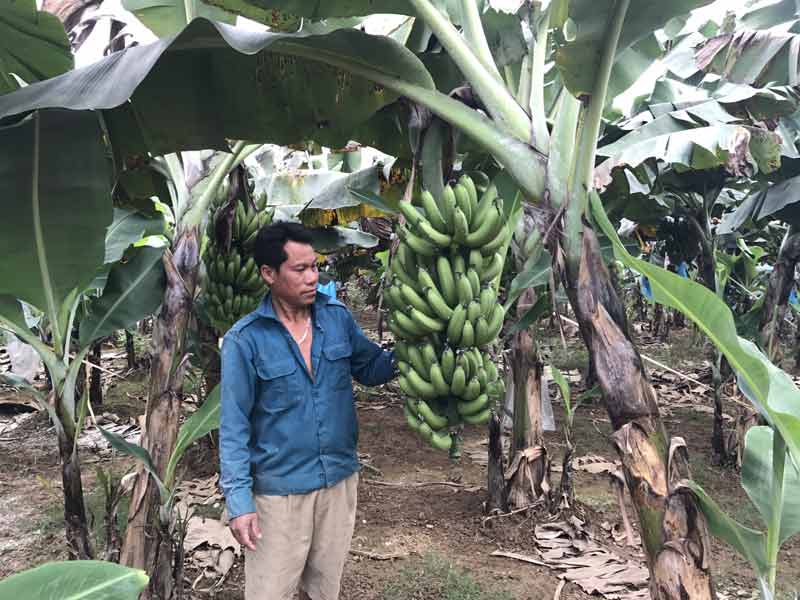
(HBO) - Tasting so many "bitter fruits" with a lot of ineffective crops, finally Mr. Bui Van Thuy, Bai village, Kim Binh commune (Kim Boi) has also found the economic development direction of the family with pink aromatic bananas. After only 3 years, sweet bananas gave Mr. Thuy the income of hundreds of millions of dongs.

The garden of pink aromatic bananas of Mr.
Bui Van Thuy, Bai village, Kim Binh commune (Kim Boi) has brought the income of
hundreds of millions of dongs every year.
We visited Mr. Thuy's banana garden just in
time it was being harvested to sell. The banana crop this year was bumper. The
bunches included beautiful and big bananas with eye-catching colors. The traders
have bought 2,000 bunches of bananas with a price of 100,000 VND a bunch. After
deducting the cost of fertilizer, seed, and care, he planned to get over 100
million VND.
Mr. Thuy says that the application of
science and technology into production has helped to significantly improve the
quality, the crop productivity, reduce the costs and bring higher profits. In
the near future, he plans to continue expanding the banana gardens, building
the models according to VietGAP standards, preliminary processing and packing
right in the garden to bring higher economic efficiency. According to his
estimation, if he plants bananas under VietGAP process, the profit will not
less than 150 million VND a hectare.
The demand of the market for this product
is large, especially the clean banana products without using chemicals and
pesticides. According to Mr. Thuy, the soil quality in the locality and some
surrounding areas are suitable for the pink aromatic bananas with high quality
and typical flavour. At the same time, the abundant water resource is an
important factor to help the model develop sustainably. To replicate the model,
put the banana trees into one of the key economic development directions,
besides the existing natural conditions, it is necessary to bring science and
technology into production and to develop towards the clean agriculture. It is
necessary to produce under the chain of value from production to consumption to
bring the highest profit, gradually building a brand of clean products with the
reputation in the market.
According to data from the Hoa Binh Provincial Party Committee, the industrial production index for the first six months of 2025 is estimated to have increased by 20% compared to the same period last year. This marks the highest year-on-year growth rate for this period since 2020.
In the first six months of 2025, Hoa Binh province’s export turnover was estimated at 1.145 billion USD, marking an 18.11% increase compared to the same period in 2024. Import turnover was estimated at $ 804 million, a 17.15% increase, which helped the province maintain a positive trade balance.
The lives of the ethnic minority farmers in Tan Lac district have gradually improved thanks to the new directions in agricultural production. This is a testament to the collective strength fostered through the professional associations and groups implemented by various levels of the district’s Farmers’ Union.
With the motto the "product quality comes first,” after nearly one year of establishment and operation, Muong village’s Clean Food Agricultural and Commercial Cooperative, located in Cau Hamlet, Hung Son Commune (Kim Boi district), has launched reputable, high-quality agricultural products to the market that are well-received by consumers. The products such as Muong village’s pork sausage, salt-cured chicken, and salt-cured pork hocks have gradually carved out a place in the market and they are on the path to obtaining the OCOP certification.
In the past, the phrase "bumper harvest, rock-bottom prices" was a familiar refrain for Vietnamese farmers engaged in fragmented, small-scale agriculture. But today, a new spirit is emerging across rural areas of Hoa Binh province - one of collaboration, organisation, and collective economic models that provide a stable foundation for production.
Maintaining growing area codes and packing facility codes in accordance with regulations is a mandatory requirement for agricultural products to be eligible for export. Recently, the Department of Agriculture and Environment of Hoa Binh province has intensified technical supervision of designated farming areas and packing facilities to safeguard the "green passport" that enables its products to access international markets.



